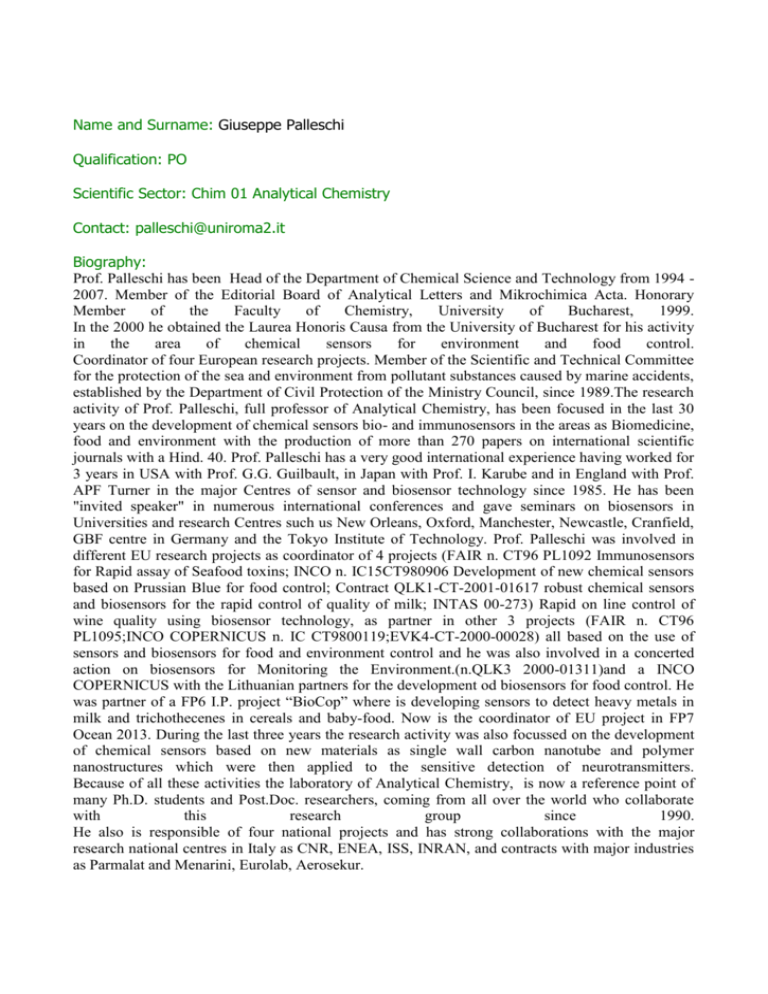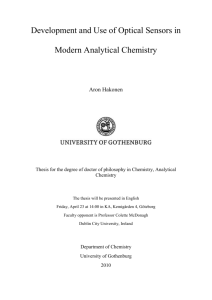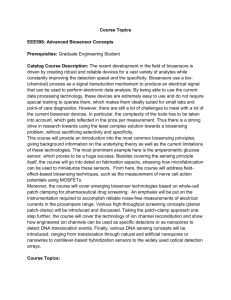Name and Surname:
advertisement

Name and Surname: Giuseppe Palleschi Qualification: PO Scientific Sector: Chim 01 Analytical Chemistry Contact: palleschi@uniroma2.it Biography: Prof. Palleschi has been Head of the Department of Chemical Science and Technology from 1994 2007. Member of the Editorial Board of Analytical Letters and Mikrochimica Acta. Honorary Member of the Faculty of Chemistry, University of Bucharest, 1999. In the 2000 he obtained the Laurea Honoris Causa from the University of Bucharest for his activity in the area of chemical sensors for environment and food control. Coordinator of four European research projects. Member of the Scientific and Technical Committee for the protection of the sea and environment from pollutant substances caused by marine accidents, established by the Department of Civil Protection of the Ministry Council, since 1989.The research activity of Prof. Palleschi, full professor of Analytical Chemistry, has been focused in the last 30 years on the development of chemical sensors bio- and immunosensors in the areas as Biomedicine, food and environment with the production of more than 270 papers on international scientific journals with a Hind. 40. Prof. Palleschi has a very good international experience having worked for 3 years in USA with Prof. G.G. Guilbault, in Japan with Prof. I. Karube and in England with Prof. APF Turner in the major Centres of sensor and biosensor technology since 1985. He has been "invited speaker" in numerous international conferences and gave seminars on biosensors in Universities and research Centres such us New Orleans, Oxford, Manchester, Newcastle, Cranfield, GBF centre in Germany and the Tokyo Institute of Technology. Prof. Palleschi was involved in different EU research projects as coordinator of 4 projects (FAIR n. CT96 PL1092 Immunosensors for Rapid assay of Seafood toxins; INCO n. IC15CT980906 Development of new chemical sensors based on Prussian Blue for food control; Contract QLK1-CT-2001-01617 robust chemical sensors and biosensors for the rapid control of quality of milk; INTAS 00-273) Rapid on line control of wine quality using biosensor technology, as partner in other 3 projects (FAIR n. CT96 PL1095;INCO COPERNICUS n. IC CT9800119;EVK4-CT-2000-00028) all based on the use of sensors and biosensors for food and environment control and he was also involved in a concerted action on biosensors for Monitoring the Environment.(n.QLK3 2000-01311)and a INCO COPERNICUS with the Lithuanian partners for the development od biosensors for food control. He was partner of a FP6 I.P. project “BioCop” where is developing sensors to detect heavy metals in milk and trichothecenes in cereals and baby-food. Now is the coordinator of EU project in FP7 Ocean 2013. During the last three years the research activity was also focussed on the development of chemical sensors based on new materials as single wall carbon nanotube and polymer nanostructures which were then applied to the sensitive detection of neurotransmitters. Because of all these activities the laboratory of Analytical Chemistry, is now a reference point of many Ph.D. students and Post.Doc. researchers, coming from all over the world who collaborate with this research group since 1990. He also is responsible of four national projects and has strong collaborations with the major research national centres in Italy as CNR, ENEA, ISS, INRAN, and contracts with major industries as Parmalat and Menarini, Eurolab, Aerosekur. Title of teaching module: Chemistry of Equilibria Description of teaching module (teaching program): Program of chemistry of equilibria 2014-15 Prof. Giuseppe Palleschi. Solutions, solvents e solutes. Concentrazioni: Percent W/W ; W/V; V/V. Chemical equilibrium Strong and weak acids Strong and weak bases pH calculation Buffers and pH calculation of a buffer solution. Buffer capacity Diprotic acids and triprotic acids. pH calculations. Ampholytes pH. Precipitation equilibria, solubility and solubility product pH and solubility . Complexation equilibria Redox equilibria, standard potentials, Nernst equation and the electro Motive force calculation. Electrolysis. Exercises







